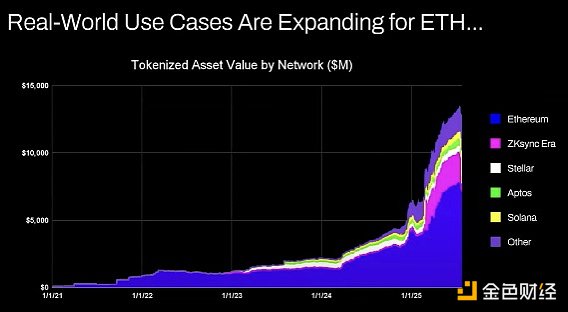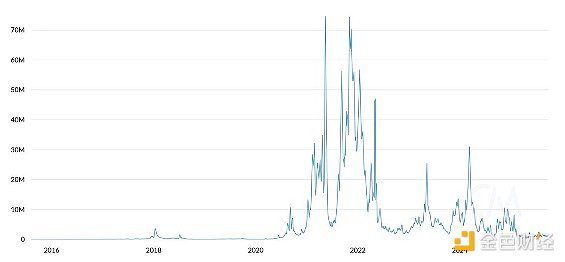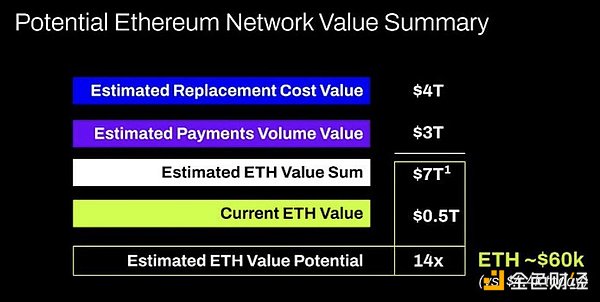I recently came across Tom Lee's ETH investment thesis, which is possibly the most ridiculous collection of financial illiteracy I've ever encountered. Let's break it down one by one. Tom Lee's thesis is based on five key points: Stablecoins and the adoption of real-world asset tokens; the digital oil analogy; institutions will purchase and stake ETH to provide security for their tokenized asset networks and as operating capital; ETH's market capitalization will be equal to the combined value of all financial infrastructure companies; and technical analysis. 1. Stablecoins and the Adoption of Real-World Asset Tokenization: This argument suggests that the growth of stablecoins and asset tokenization activity should drive up trading volume, and in turn, drive up ETH fees/revenue. While this seems reasonable on the surface, a few minutes of data verification reveals otherwise.


Since 2020, the value of tokenized assets and stablecoin trading volume have increased 100-1000 times. Tom's argument fundamentally misunderstands the value accrual mechanism. It might lead you to believe that fees will scale year-over-year, but in reality, they remain roughly the same as in 2020. Here are the reasons: Ethereum network upgrades have improved transaction efficiency; stablecoin and tokenized asset activity has shifted to other chains; tokenizing low-liquidity assets generates almost no fees. Tokenized value isn't directly correlated with ETH revenue. Someone could tokenize $100 million in bonds. If they traded them every two years, how much would that translate into ETH fees? About $0.10? A single USDT transaction would generate significantly more in fees. Even if a trillion dollars in assets were tokenized, if their liquidity was low, it might only add $100,000 in ETH value. Will blockchain transaction volume and fees increase? Yes, but most of these fees will be captured by other blockchains with greater business expansion capabilities. Other competitors are actively seizing opportunities in the blockchain space for bringing traditional financial transactions to blockchains. Solana, Arbitrum, and Tempo have already achieved significant early success. Even Tether is supporting two new chains, Plasma and Stable, both of which aim to shift USDT trading volume to their own chains. 2. Digital Oil Analogy Oil is a commodity. Real, inflation-adjusted oil prices have fluctuated within the same range for over a century, with only periodic spikes and declines. I agree with Tom's view of ETH as a commodity, but that's not a positive development. I'm not sure what Tom is trying to argue here! 3. Institutions will purchase and stake ETH to provide security for their asset tokenization networks and as operating capital. Have large banks and other financial institutions already allocated ETH on their balance sheets? No.
Has any organization announced any plans to do so? No.
Will banks stockpile gasoline due to continued energy consumption? No, because the proportion is too small, they can simply purchase it when needed.
Will banks purchase shares in the asset custodians they use? No.
4. ETH's market capitalization will be equal to the combined value of all financial infrastructure companies

My point is, this once again exposes a fundamental misunderstanding of the value accumulation mechanism and is pure delusion.
5. Technical Analysis
I'm actually a big believer in technical analysis and believe its objective application is extremely valuable. Unfortunately, Tom seems to be using technical analysis to arbitrarily draw lines to support his biases. Looking objectively at this chart, the most striking observation is that Ethereum is in a multi-year range. This is similar to the wide range-bound behavior of crude oil prices over the past three decades. Not only are we range-bound, but we recently hit the top of the range and failed to break through resistance. If anything, the technical picture for Ethereum is bearish. I cannot rule out the possibility of a prolonged period of consolidation between $1,000 and $4,800. Past parabolic rallies by no means guarantee their indefinite continuation. The long-term ETH/BTC chart is also misinterpreted. The pair is indeed in a multi-year range, but has been primarily constrained by a downtrend over the past few years, with only a recent bounce off long-term support. This downward trend is driven by a saturated narrative surrounding Ethereum and an inability of fundamentals to support valuation growth. These fundamentals remain unchanged. Ethereum's valuation stems primarily from the effects of financial illiteracy. To be fair, this can create significant market capitalization (see XRP). However, the valuations that financial illiteracy can support are not infinite. Macro liquidity is keeping ETH's market capitalization afloat, but unless significant organizational change occurs, it is likely destined for continued underperformance.
 Jixu
Jixu








